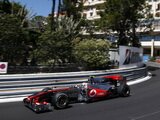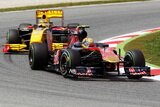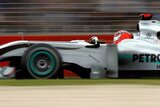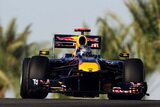This in turn reduces the risk of the neck and skull fractures which are the greatest cause of death in racing accidents. Yet unlike the 'active' safety features modern road cars tend to be equipped with, such as airbags and explosive seatbelt pre-tensioners, HANS is entirely passive and does not require any electronic sensors or power supply.
The HANS system was invented in the mid 1980s by Dr.Robert Hubbard, a biomechanical engineering professor at Michigan State University in the USA. The principle behind it is simple. Although a driver's body is firmly strapped to the body of a race car through safety harnesses, his (or her) head and neck are unsupported in the event of an accident. Indeed, a race driver's helmet will actually increase the weight of the head, and the pendulum momentum of the forward swing that has to be absorbed by the neck muscles. These are the 'whiplash' injuries common in road accidents, although the forces involved in Formula One crashes are - of course - much higher.
The HANS system consists of a carbon fibre 'collar' worn by the driver around his neck and fitted under the shoulder belts of the safety harness. The helmet is then loosely connected to the collar by two tethers, which allow free movement of the head in normal operation. In the event of a frontal impact the amount of helmet deflection will be controlled by these tethers, while the collar is locked in place by the tightening safety harness. The energy absorbed by the driver's neck and skull is dramatically reduced, while the helmet loading is also transferred from the base of the skull to the forehead - which is far better suited to taking the force.
The original HANS device went on sale in 1990 but the large collar was unsuited to Formula One or other single seat disciplines with narrow, tight cockpits. After Mika Hakkinen's enormous accident in Adelaide in 1995 (in which he fractured his skull) the FIA instituted a research programme in conjunction with DaimlerChrysler to establish the best way of protecting drivers' heads in major impacts. Airbag and 'active' safety systems were briefly considered, but the research emphasis then shifted to HANS and the development of a version of the system suitable for Formula One.
During testing the benefits of the system became apparent, figures suggesting than HANS reduced typical head motion by 44 percent, the force applied to the neck by 86 percent and the acceleration applied to the head by 68 percent - bringing the figures for even large impacts under the 'injury threshold'.
The revised system was certified for Formula One and became mandatory for all drivers from the start of the 2003 season. Although some drivers complained of discomfort wearing the system over a full race distance, it has generally been accepted as a sensible way of reducing the very real risk of injury. As such it stands as evidence of Formula One's very real commitment to driver safety.
formula1.com
Comments:








